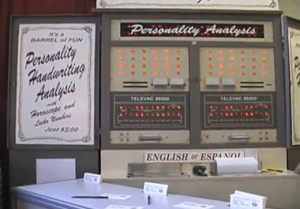 When I was a kid, we went to the Bloomsburg Fair every year, rain or shine. The Fair has been a magical place for generations of kids (no matter their age) and a place of hope as well. It’s been held in late September since 1855, and hundreds of thousands of people come every year for miles around, making it the biggest fair in the Commonwealth of Pennsylvania.
When I was a kid, we went to the Bloomsburg Fair every year, rain or shine. The Fair has been a magical place for generations of kids (no matter their age) and a place of hope as well. It’s been held in late September since 1855, and hundreds of thousands of people come every year for miles around, making it the biggest fair in the Commonwealth of Pennsylvania.
It’s an agricultural/exhibit fair, and my mom tells me that during the Great Depression, many folks relied (some fairly desperately) on winning cash prizes for things they grew, bottled, jarred, knitted, sewed and showed at the Fair. Slightly more recently, the Bloomsburg Fair was the place where Taylor Swift made her concert debut. So I suppose it’s always been a place where dreams (and money) are made.
Every year as we shuffled through the crowds, I was drawn to a crazy handwriting analysis booth that was always in the exact same location, its back to the racetrack near the richly fragrant Grotto Pizza stand and the ginormous bingo tent where I won a table lamp one year.
The handwriting booth had these massive reel-to-reel tapes going around and around, digital noises bleeping, and blinking lights flashing. There was a creepy electronic voice claiming that handwriting analysis could tell you everything you wanted to know – it was the Wave of the Future! I was just fascinated by the thought that you could throw a scrap of paper into a computer and out would pop reams of Knowledge.
(Hunh. Look at me now. Putting little bits of information into a computer to gather knowledge. Blinking lights (see that cursor?), digital noises and all.)
Remembering that booth got me thinking about all of the data we amass and put into the database when we build relationships with donors and how we make that system work better for us.
These past few weeks, I’ve been talking about ratings – codes – you can use to organize and rank prospects in a relationship management system. These codes are capacity, readiness, inclination, and prospect status.
Taking these forward a bit now, I want to add a new dimension.
Let’s say that each of these codes are assigned a weighted value, and can be used – automatically – to help you prioritize your relationship management system. You get to decide which values are more important, and using this weighting system you generate new lists (and move assignments around) weekly, daily, or instantly.
Let me show you more practically what I mean.
LARGE SHOP EXAMPLE
Take for example a person
- with a rating of 5m+,
- with an inclination of 1 (they love your organization!),
- with a readiness code showing that you will be asking them for a gift in the next 3-6 months and
- with a prospect status of Ask.
As someone at the very pinnacle of our relationship mountain, they would be weighted with the highest numbers.
Moving further down the pipeline, prospects would be weighted less heavily, and you can decide which codes take precedence. Is it capacity? Inclination? Readiness? How do you want to manage the subtleties of your weighting system?
Now think about how you can use these weightings to automatically rank prospects. What if you set up your database or work sheet to automatically weight potential donors who are just being discovered based on the info you have? Once ratings are set for new prospects they can be inserted directly into relationship managers’ portfolios based on class, geography, membership type, interest…or whatever you use as the system of assignment.
MEDIUM/SMALL SHOP EXAMPLE
Let’s say you don’t have the ability to program your database (or Excel) to automatically weight codes to rank prospects. You can still do it manually, and it’s not hard. All you need is to be able to draw a grid on a piece of paper or on your computer.
My colleague Chris Carnie, of The Factary Ltd. in Bristol, England shared a terrific, simple ranking system with me for Prospect Research for Fundraisers. Found on p. 98, his system allows small-to-medium shops to rank and prioritize prospects in a straightforward database-free way. Give it a try and see if it doesn’t help you plan better.
How will you automate your relationship management system in the years to come? Have you already started riding the wave of the future?
